Produkte
-

KrakenRF Magnetische ausziehbare Antennen für KrakenSDR (Set mit 5 Stück)
Ein Satz von fünf magnetischen, ausziehbaren Teleskopantennen mit einem Abstimmungsbereich von 100 MHz bis 1 GHz, die mit KrakenSDR zur Richtungsermittlung verwendet werden können. Die Magnete sind stark und halten sicher auf dem Dach eines fahrenden Autos. Enthält ein Set von fünf zwei Meter langen Koaxialkabeln vom Typ LMR100, die auf gleiche Länge abgestimmt wurden, um eine bessere Leistung zu erzielen.
€ 259,00€ 219,00
Mitglieder identisch
-
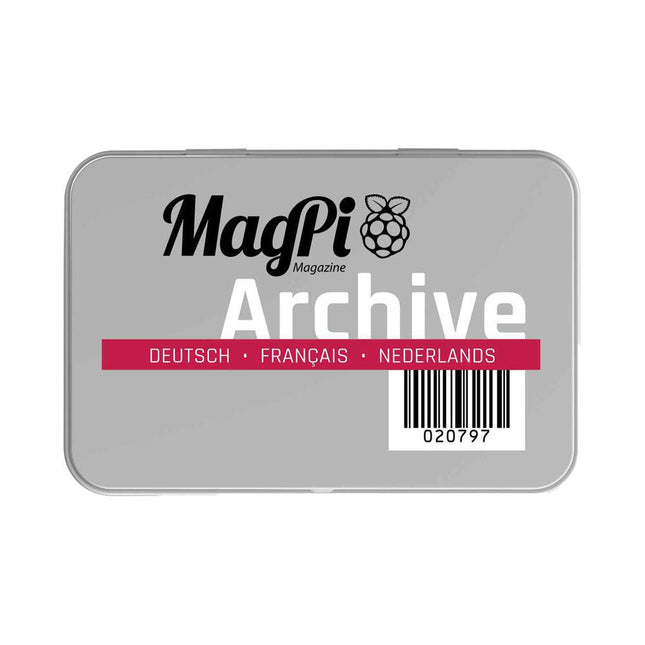
MagPi Archiv (USB-Stick)
Über 8 MagPi Jahrgänge (2016 bis 2024) auf USB-Stick Dieser USB-Stick enthält alle MagPi Ausgaben der Jahrgänge 2016 bis Januar/Februar 2024 sowie 2 Elektor-Kompilationen mit Raspberry Pi-Schaltungen im PDF-Format. Die neueste Ausgabe (März/April 2024) kann jedoch bereits jetzt für jedermann kostenlos heruntergeladen werden. MagPi ist das offizielle Magazin der Raspberry Pi Foundation und enthält Reviews, Tutorials und DIY-Projekte über und mit dem Raspberry Pi.
€ 69,95€ 44,95
Mitglieder identisch
-

Cytron MakerDisk M.2 SSD mit vorinstalliertem Raspberry Pi OS (128 GB)
Diese NVMe M.2 2242 SSD (128 GB) ist ab Werk für die sofortige Nutzung mit dem Raspberry Pi 5 M.2 HAT+ bereits mit Raspberry Pi OS vorinstalliert. Features Formfaktor: M.2 2242 M-Key NVMe SSD Vorinstalliert mit Raspberry Pi OS Hohe Widerstandsfähigkeit gegen Stöße, Vibrationen und hohe Temperaturen SMART TRIM-Unterstützung PCIe-Schnittstelle: PCIe Gen3 x2 Konformität: NVMe 1.3, PCI Express Base 3.1 Kapazität: 128 GB Geschwindigkeit: Lesen Sie: Bis zu 1700 MB/s Schreiben: Bis zu 600 MB/s Stoß: 1500 G/0,5 ms Betriebstemperatur: 0°C–70°C Bis zu 30x schneller als eine typische Festplatte Steigert die Burst-Schreibleistung und ist somit ideal für typische Computer-Workloads Schnelleres Hochfahren, Herunterfahren, Laden der Anwendung und schnellere Reaktion für Raspberry Pi Downloads Datasheet
€ 49,95€ 37,50
Mitglieder identisch
-
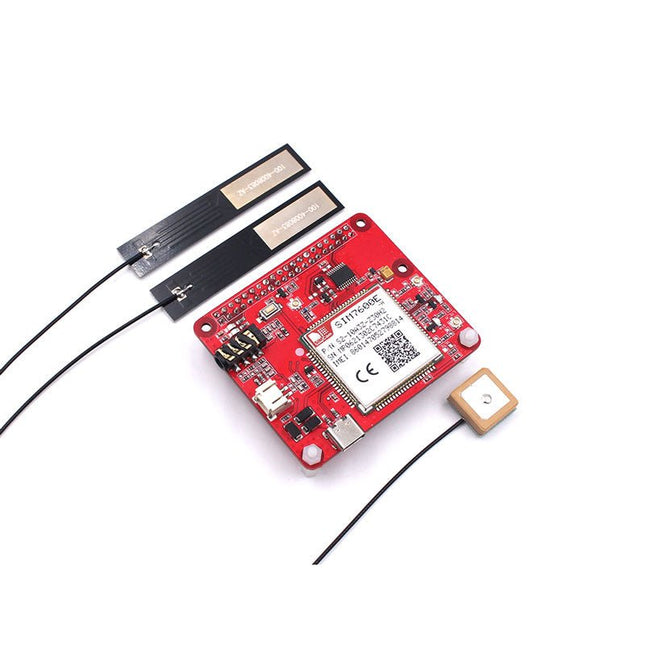
Makerfabs Makerfabs 4G LTE Hat für Raspberry Pi
Verwenden Sie Ihren Raspberry Pi mit LTE Cat-4 4G/3G/2G Kommunikation & GNSS Positionierung, für Ferndatenübertragung/Telefon/SMS, geeignet für Fernüberwachung/Alarmierung. Dieser 4G Hut basiert auf dem Maduino Zero 4G LTE, jedoch ohne Controller. Er muss mit dem Raspberry Pi (2x20 Stecker und USB) funktionieren. Der Raspberry kommuniziert mit diesem HAT mit einfachen AT-Befehlen (über die TX/RX Pins im 2X20-Anschluss) für einfache Steuerungen, wie SMS/Phone/GNSS; mit dem USB-Anschluss und dem richtigen Linux-Treiber installiert, fungiert der 4G-Hut als 4G-Netzwerkadapter, der auf das Internet zugreifen und Daten mit dem 4G-Protokoll übertragen kann. Im Vergleich zu einem normalen USB 4G Dongle hat dieser Raspberry Pi 4G Hat die folgenden Vorteile: Onboard Audio Codec, damit Sie direkt mit Ihrem RPI kommunizieren können, oder Auto-Broadcasting mit einem Lautsprecher Hardware-UART-Kommunikation, Hardware-Steuerung der Stromversorgung (durch 2s-Impuls von PI GPIO oder POWERKEY-Taste), Hardware-Steuerung des Flugmodus Dual LTE 4G Antenne, plus GPS Antenne Merkmale LTE Cat-4, mit Uplink-Rate 50 Mbps und Downlink-Rate 150 Mbps GNSS-Positionierung Audio-Treiber NAU8810 Unterstützt Einwahl, Telefon, SMS, TCP, UDP, DTMF, HTTP, FTP und so weiter Unterstützt GPS, BeiDou, Glonass, LBS-Basisstation Positionierung SIM-Kartensteckplatz, unterstützt 1,8V/3V SIM-Karten Integrierte Audiobuchse und Audiodecoder für Telefonanrufe 2x LED-Anzeigen, einfach zu überwachen den Arbeitsstatus Unterstützt SIM-Anwendungs-Toolkit: SAT Klasse 3, GSM 11.14 Release 99, USAT Lieferumfang 1x 4G LTE Hat für Raspberry Pi 1x GPS antenna 2x 4G LTE antenna 2x Standoff Downloads GitHub
€ 99,95€ 79,95
Mitglieder identisch
-
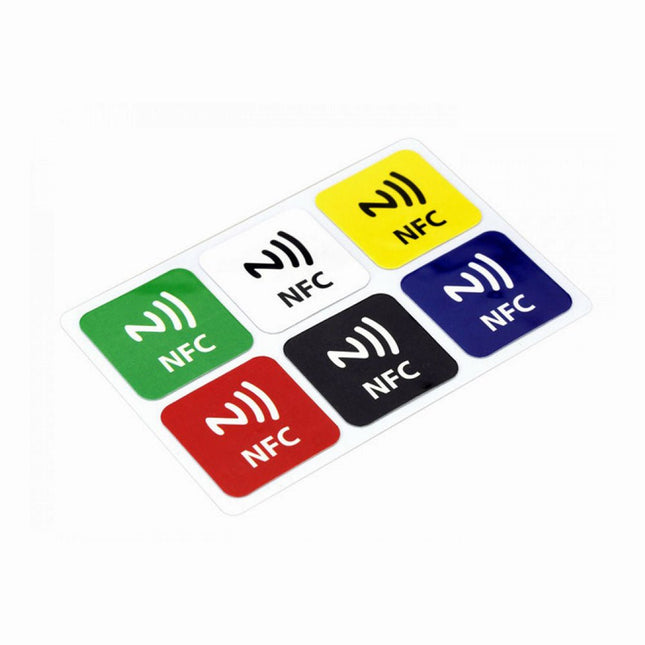
Makerfabs Makerfabs NFC-Aufkleber (6 Stück)
Merkmale NFC-Chipmaterial: PET + Ätzantenne Chip: NTAG216 (kompatibel mit allen NFC-Telefonen) Frequenz: 13,56 MHz (Hochfrequenz) Lesezeit: 1 - 2 ms Speicherkapazität: 888 Byte Lese- und Schreibvorgänge: > 100.000 Mal Leseabstand: 0 - 5 mm Datenaufbewahrung: > 10 Jahre NFC-Chipgröße: Durchmesser 30 mm Berührungslos, keine Reibung, geringe Ausfallrate, geringe Wartungskosten Leserate, Verifizierungsgeschwindigkeit, die effektiv Zeit sparen und die Effizienz verbessern kann Wasserdicht, staubdicht, vibrationshemmend Keine Stromversorgung mit Antenne, eingebetteter Verschlüsselungssteuerungslogik und Kommunikationslogikschaltung Inbegriffen 1x NFC-Sticker (6-Farben-Set)
€ 9,95
Mitglieder € 8,96
-
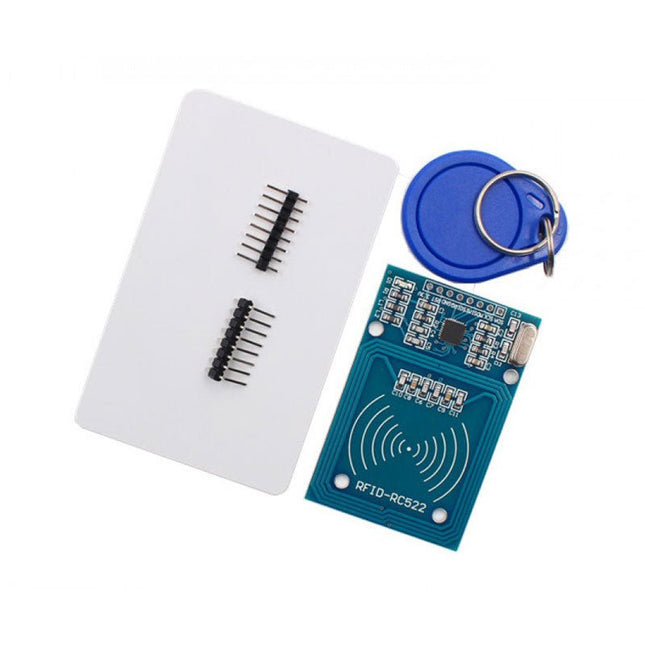
Makerfabs Makerfabs RC522 RFID-Lesegerät mit Karten-Kit (13,56 MHz)
Dieses RC522-RFID-Kit enthält ein 13,56-MHz-RF-Lesemodul, das einen RC522-IC und zwei S50-RFID-Karten verwendet, um Sie beim Erlernen und Hinzufügen des 13,56-MHz-RF-Übergangs zu Ihrem Projekt zu unterstützen. Der MF RC522 ist ein hochintegriertes Übertragungsmodul für die kontaktlose Kommunikation bei 13,56 MHz. Der RC522 unterstützt den ISO 14443A/MIFARE-Modus. Das Modul verwendet SPI zur Kommunikation mit Mikrocontrollern. In der Open-Hardware-Community gibt es bereits viele Projekte, die die RC522 - RFID-Kommunikation mit Arduino nutzen. Merkmale Betriebsstrom: 13-26 mA/DC 3,3 V Leerlaufstrom: 10-13 mA/DC 3,3 V Strom im Ruhezustand: Spitzenstrom: Betriebsfrequenz: 13,56 MHz Unterstützte Kartentypen: mifare1 S50, mifare1 S70, MIFARE Ultralight, Mifare Pro, MIFARE DESFire Umgebungsbedingungen Betriebstemperatur: -20-80 Grad Celsius Umgebungstemperatur bei Lagerung: -40-85 Grad Celsius Relative Luftfeuchtigkeit: relative Luftfeuchtigkeit 5% -95% Leserabstand: ≥50 mm/1.95' (Mifare 1) Modulgröße: 40×60 mm/1.57*2.34' Modul-Schnittstellen SPI Parameter Datenübertragungsrate: maximal 10 Mbit/s Lieferumfang 1x RFID-RC522 Modul 1x Standard S50 Blankokarte 1x S50-Spezialkarte (wie durch die Form des Schlüsselrings angezeigt) 1x Gerader Stift 1x Gebogener Stift Downloads Arduino Library MFRC522 Datasheet MFRC522_ANT Mifare S50
€ 5,95€ 3,95
Mitglieder identisch
-
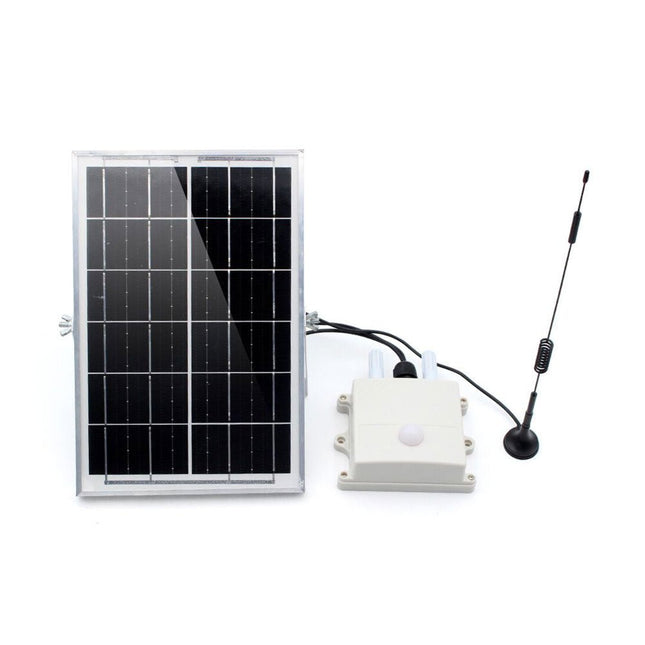
Makerfabs Makerfabs SenseLoRa Luftmonitor in Industriequalität (EU868)
Dieser Luftmonitor wird speziell zur Überwachung von Gewächshäusern verwendet. Es erkennt: Lufttemperatur & Luftfeuchtigkeit CO2-Konzentration Lichtintensität Übertragen Sie anschließend die Daten per LoRa P2P an den LoRa-Empfänger (auf Ihrem Schreibtisch im Raum), damit der Benutzer den Feldstatus überwachen oder für eine Langzeitanalyse aufzeichnen lassen kann. Dieses Modul überwacht den Gewächshausfeldstatus und sendet alle Sensordaten regelmäßig über LoRa P2P im Jason-Format. Dieses LoRa-Signal kann vom Makerfabs LoRa-Empfänger empfangen und somit auf dem PC angezeigt/aufgezeichnet/analysiert werden. Der Überwachungsname/Datenzyklus kann mit einem Telefon eingestellt werden, sodass er einfach in die Datei implementiert werden kann. Dieser Luftwächter wird von einem internen LiPo-Akku gespeist, der über ein Solarpanel aufgeladen wird, und kann mit der Standardeinstellung (Zyklus 1 Stunde) mindestens 1 Jahr lang verwendet werden. Features ESP32S3-Modul an Bord mit WLAN und Bluetooth Bereit zum Gebrauch: Schalten Sie es direkt ein, um es zu verwenden Modulname/Signalintervall einfach per Telefon einstellbar IP68 wasserdicht Temperatur: -40°C~80°C, ±0,3 Luftfeuchtigkeit: 0–100% Feuchtigkeit CO2: 0~1000 ppm Lichtintensität: 1-65535 lx Kommunikationsentfernung: Lora: >3 km 1000-mAh-Akku, integriertes Ladegerät-IC Solarpanel 6 W: Stellen Sie sicher, dass das System funktioniert. Downloads Manual BH1750 Datasheet SGP30 Datasheet
€ 69,95€ 59,95
Mitglieder identisch
-
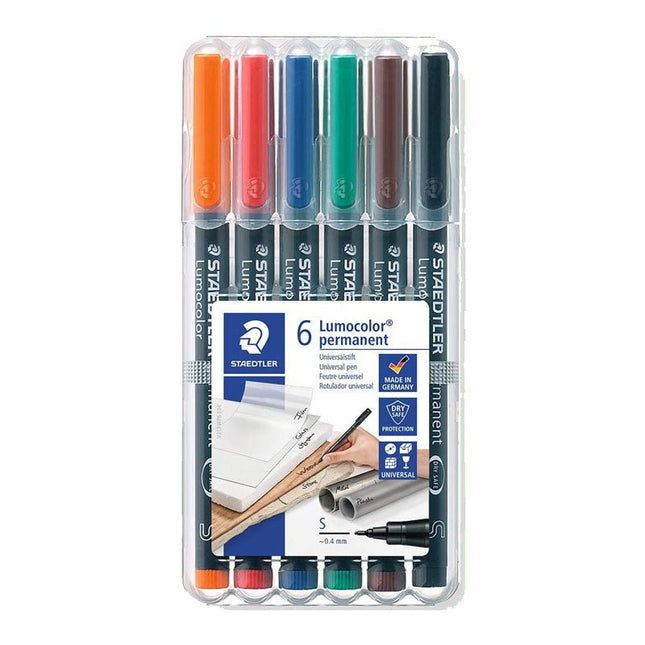
STAEDTLER Permanent-Universalstifte für den EggBot (6er-Set)
Universalstift für fast alle Oberflächen Für Overhead-Projektion geeignet Auch für CD/DVD Beschriftung geeignet Hervorragend wisch- und wasserfest auf fast allen Flächen Sekundenschnell trocken, daher ideal für Linkshänder Permanente, geruchsarme Tinte Lichtechte Farben: schwarz, braun Wetterfeste Farbe schwarz STAEDTLER Box, aufstellbar Schaft und Kappe aus PP garantieren lange Lebensdauer DRY SAFE - kann tagelang offen liegen ohne einzutrocknen (Prüfklima nach ISO 554) Airplane safe - automatischer Druckausgleich verhindert das Auslaufen des Stiftes im Flugzeug Xylol- und toluolfreie Tinte Hervorragende Farbbrillanz Linienbreite S - Superfein (ca. 0.4 mm) Nachfüllbar
€ 10,95
Mitglieder € 9,86
-
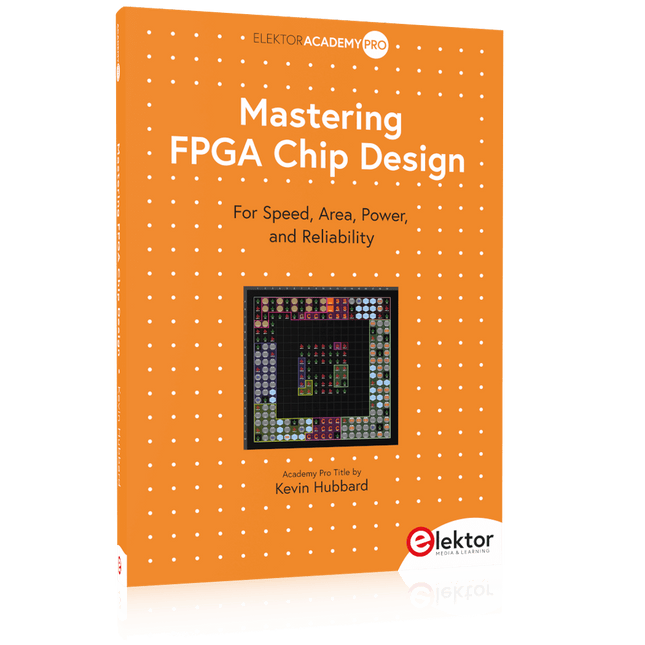
Elektor Publishing Mastering FPGA Chip Design
For Speed, Area, Power, and Reliability This book teaches the fundamentals of FPGA operation, covering basic CMOS transistor theory to designing digital FPGA chips using LUTs, flip-flops, and embedded memories. Ideal for electrical engineers aiming to design large digital chips using FPGA technology. Discover: The inner workings of FPGA architecture and functionality. Hardware Description Languages (HDL) like Verilog and VHDL. The EDA tool flow for converting HDL source into a functional FPGA chip design. Insider tips for reliable, low power, and high performance FPGA designs. Example designs include: Computer-to-FPGA UART serial communication. An open-source Sump3 logic analyzer implementation. A fully functional graphics controller. What you need: Digilent BASYS3 or similar FPGA eval board with an AMD/Xilinx FPGA. Vivado EDA tool suite (available for download from AMD website free of charge). Project source files available from author’s GitHub site.
€ 39,95€ 32,95
Mitglieder identisch
-

Elektor Digital Mastering FPGA Chip Design (E-book)
For Speed, Area, Power, and Reliability This book teaches the fundamentals of FPGA operation, covering basic CMOS transistor theory to designing digital FPGA chips using LUTs, flip-flops, and embedded memories. Ideal for electrical engineers aiming to design large digital chips using FPGA technology. Discover: The inner workings of FPGA architecture and functionality. Hardware Description Languages (HDL) like Verilog and VHDL. The EDA tool flow for converting HDL source into a functional FPGA chip design. Insider tips for reliable, low power, and high performance FPGA designs. Example designs include: Computer-to-FPGA UART serial communication. An open-source Sump3 logic analyzer implementation. A fully functional graphics controller. What you need: Digilent BASYS3 or similar FPGA eval board with an AMD/Xilinx FPGA. Vivado EDA tool suite (available for download from AMD website free of charge). Project source files available from author’s GitHub site.
€ 32,95
Mitglieder € 26,36
-

Elektor Publishing Mastering Microcontrollers Helped by Arduino (3rd Edition)
Third, extended and revised edition with AVR Playground and Elektor Uno R4 Arduino boards have become hugely successful. They are simple to use and inexpensive. This book will not only familiarize you with the world of Arduino but it will also teach you how to program microcontrollers in general. In this book theory is put into practice on an Arduino board using the Arduino programming environment. Some hardware is developed too: a multi-purpose shield to build some of the experiments from the first 10 chapters on; the AVR Playground, a real Arduino-based microcontroller development board for comfortable application development, and the Elektor Uno R4, an Arduino Uno R3 on steroids. The author, an Elektor Expert, provides the reader with the basic theoretical knowledge necessary to program any microcontroller: inputs and outputs (analog and digital), interrupts, communication busses (RS-232, SPI, I²C, 1-wire, SMBus, etc.), timers, and much more. The programs and sketches presented in the book show how to use various common electronic components: matrix keyboards, displays (LED, alphanumeric and graphic color LCD), motors, sensors (temperature, pressure, humidity, sound, light, and infrared), rotary encoders, piezo buzzers, pushbuttons, relays, etc. This book will be your first book about microcontrollers with a happy ending! This book is for you if you are a beginner in microcontrollers, an Arduino user (hobbyist, tinkerer, artist, etc.) wishing to deepen your knowledge,an Electronics Graduate under Undergraduate student or a teacher looking for ideas. Thanks to Arduino the implementation of the presented concepts is simple and fun. Some of the proposed projects are very original: Money Game Misophone (a musical fork) Car GPS Scrambler Weather Station DCF77 Decoder Illegal Time Transmitter Infrared Remote Manipulator Annoying Sound Generator Italian Horn Alarm Overheating Detector PID Controller Data Logger SVG File Oscilloscope 6-Channel Voltmeter All projects and code examples in this book have been tried and tested on an Arduino Uno board. They should also work with the Arduino Mega and every other compatible board that exposes the Arduino shield extension connectors. Please note For this book, the author has designed a versatile printed circuit board that can be stacked on an Arduino board. The assembly can be used not only to try out many of the projects presented in this book but also allows for new exercises that in turn provide the opportunity to discover new techniques. Also available is a kit of parts including the PCB and all components. With this kit you can build most of the circuits described in the book and more. Datasheets Active Components Used (.PDF file): ATmega328 (Arduino Uno) ATmega2560 (Arduino Mega 2560) BC547 (bipolar transistor, chapters 7, 8, 9) BD139 (bipolar power transistor, chapter 10) BS170 (N-MOS transistor, chapter 8) DCF77 (receiver module, chapter 9) DS18B20 (temperature sensor, chapter 10) DS18S20 (temperature sensor, chapter 10) HP03S (pressure sensor, chapter 8) IRF630 (N-MOS power transistor, chapter 7) IRF9630 (P-MOS power transistor, chapter 7) LMC6464 (quad op-amp, chapter 7) MLX90614 (infrared sensor, chapter 10) SHT11 (humidity sensor, chapter 8) TS922 (dual op-amp, chapter 9) TSOP34836 (infrared receiver, chapter 9) TSOP1736 (infrared receiver, chapter 9) MPX4115 (analogue pressure sensor, chapter 11) MCCOG21605B6W-SPTLYI (I²C LCD, chapter 12) SST25VF016B (SPI EEPROM, chapter 13) About the author Clemens Valens, born in the Netherlands, lives in France since 1997. Manager at Elektor Labs and Webmaster of ElektorLabs, in love with electronics, he develops microcontroller systems for fun, and sometimes for his employer too. Polyglot—he is fluent in C, C++, PASCAL, BASIC and several assembler dialects—Clemens spends most of his time on his computer while his wife, their two children and two cats try to attract his attention (only the cats succeed). Visit the author’s website: www.polyvalens.com.Authentic testimony of Hervé M., one of the first readers of the book:'I almost cried with joy when this book made me understand things in only three sentences that seemed previously completely impenetrable.'
€ 49,95
Mitglieder € 44,96
-

Elektor Digital Mastering Microcontrollers Helped by Arduino (3rd Edition) | E-book
Third, extended and revised edition with AVR Playground and Elektor Uno R4 Arduino boards have become hugely successful. They are simple to use and inexpensive. This book will not only familiarize you with the world of Arduino but it will also teach you how to program microcontrollers in general. In this book theory is put into practice on an Arduino board using the Arduino programming environment. Some hardware is developed too: a multi-purpose shield to build some of the experiments from the first 10 chapters on; the AVR Playground, a real Arduino-based microcontroller development board for comfortable application development, and the Elektor Uno R4, an Arduino Uno R3 on steroids. The author, an Elektor Expert, provides the reader with the basic theoretical knowledge necessary to program any microcontroller: inputs and outputs (analog and digital), interrupts, communication busses (RS-232, SPI, I²C, 1-wire, SMBus, etc.), timers, and much more. The programs and sketches presented in the book show how to use various common electronic components: matrix keyboards, displays (LED, alphanumeric and graphic color LCD), motors, sensors (temperature, pressure, humidity, sound, light, and infrared), rotary encoders, piezo buzzers, pushbuttons, relays, etc. This book will be your first book about microcontrollers with a happy ending! This book is for you if you are a beginner in microcontrollers, an Arduino user (hobbyist, tinkerer, artist, etc.) wishing to deepen your knowledge,an Electronics Graduate under Undergraduate student or a teacher looking for ideas. Thanks to Arduino the implementation of the presented concepts is simple and fun. Some of the proposed projects are very original: Money Game Misophone (a musical fork) Car GPS Scrambler Weather Station DCF77 Decoder Illegal Time Transmitter Infrared Remote Manipulator Annoying Sound Generator Italian Horn Alarm Overheating Detector PID Controller Data Logger SVG File Oscilloscope 6-Channel Voltmeter All projects and code examples in this book have been tried and tested on an Arduino Uno board. They should also work with the Arduino Mega and every other compatible board that exposes the Arduino shield extension connectors. Please note For this book, the author has designed a versatile printed circuit board that can be stacked on an Arduino board. The assembly can be used not only to try out many of the projects presented in this book but also allows for new exercises that in turn provide the opportunity to discover new techniques. Also available is a kit of parts including the PCB and all components. With this kit you can build most of the circuits described in the book and more. Datasheets Active Components Used (.PDF file): ATmega328 (Arduino Uno) ATmega2560 (Arduino Mega 2560) BC547 (bipolar transistor, chapters 7, 8, 9) BD139 (bipolar power transistor, chapter 10) BS170 (N-MOS transistor, chapter 8) DCF77 (receiver module, chapter 9) DS18B20 (temperature sensor, chapter 10) DS18S20 (temperature sensor, chapter 10) HP03S (pressure sensor, chapter 8) IRF630 (N-MOS power transistor, chapter 7) IRF9630 (P-MOS power transistor, chapter 7) LMC6464 (quad op-amp, chapter 7) MLX90614 (infrared sensor, chapter 10) SHT11 (humidity sensor, chapter 8) TS922 (dual op-amp, chapter 9) TSOP34836 (infrared receiver, chapter 9) TSOP1736 (infrared receiver, chapter 9) MPX4115 (analogue pressure sensor, chapter 11) MCCOG21605B6W-SPTLYI (I²C LCD, chapter 12) SST25VF016B (SPI EEPROM, chapter 13) About the author Clemens Valens, born in the Netherlands, lives in France since 1997. Manager at Elektor Labs and Webmaster of ElektorLabs, in love with electronics, he develops microcontroller systems for fun, and sometimes for his employer too. Polyglot—he is fluent in C, C++, PASCAL, BASIC and several assembler dialects—Clemens spends most of his time on his computer while his wife, their two children and two cats try to attract his attention (only the cats succeed). Visit the author’s website: www.polyvalens.com.Authentic testimony of Hervé M., one of the first readers of the book:'I almost cried with joy when this book made me understand things in only three sentences that seemed previously completely impenetrable.'
€ 34,95
Mitglieder € 27,96
-

Elektor Digital Mastering Surface Mount Technology (E-book)
Mastering Surface Mount Technology takes you on a crash course in techniques, tips and know-how to successfully introduce surface mount technology in your workflow. Even if you are on a budget you too can jumpstart your designs with advanced fine pitch parts. Besides explaining methodology and equipment, attention is given to SMT parts technologies and soldering methods. In a step by step way, several projects introduce you to handling surface mount parts and the required skills to successfully build SMT assemblies. Many practical tips and tricks are disclosed that bring surface mount technology into everyone's reach without breaking the bank.
€ 34,95
Mitglieder € 27,96
-
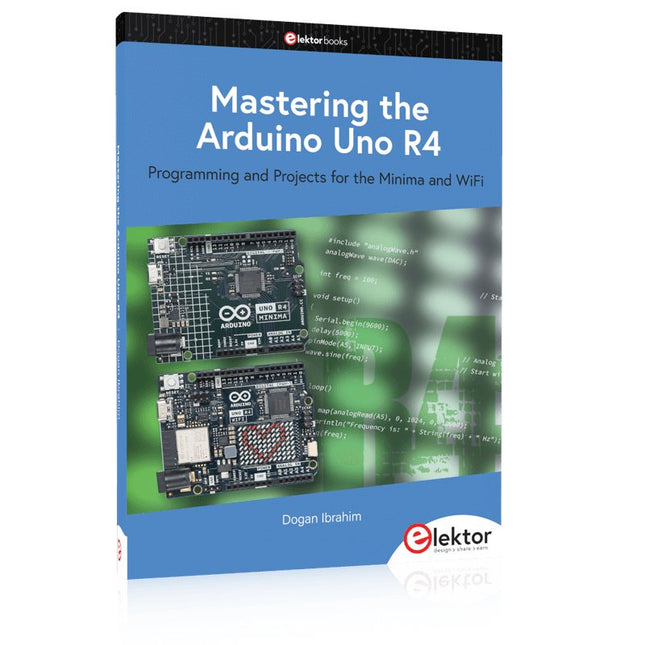
Elektor Publishing Mastering the Arduino Uno R4
Programming and Projects for the Minima and WiFi Based on the low-cost 8-bit ATmega328P processor, the Arduino Uno R3 board is likely to score as the most popular Arduino family member so far, and this workhorse has been with us for many years. Recently, the new Arduino Uno R4 was released, based on a 48-MHz, 32-bit Cortex-M4 processor with a huge amount of SRAM and flash memory. Additionally, a higher-precision ADC and a new DAC are added to the design. The new board also supports the CAN Bus with an interface. Two versions of the board are available: Uno R4 Minima, and Uno R4 WiFi. This book is about using these new boards to develop many different and interesting projects with just a handful of parts and external modules, which are available as a kit from Elektor. All projects described in the book have been fully tested on the Uno R4 Minima or the Uno R4 WiFi board, as appropriate. The project topics include the reading, control, and driving of many components and modules in the kit as well as on the relevant Uno R4 board, including LEDs 7-segment displays (using timer interrupts) LCDs Sensors RFID Reader 4×4 Keypad Real-time clock (RTC) Joystick 8×8 LED matrix Motors DAC (Digital-to-analog converter) LED matrix WiFi connectivity Serial UART CAN bus Infrared controller and receiver Simulators … all in creative and educational ways with the project operation and associated software explained in great detail.
€ 39,95
Mitglieder € 35,96
-

Elektor Digital Mastering the Arduino Uno R4 (E-book)
Programming and Projects for the Minima and WiFi Based on the low-cost 8-bit ATmega328P processor, the Arduino Uno R3 board is likely to score as the most popular Arduino family member so far, and this workhorse has been with us for many years. Recently, the new Arduino Uno R4 was released, based on a 48-MHz, 32-bit Cortex-M4 processor with a huge amount of SRAM and flash memory. Additionally, a higher-precision ADC and a new DAC are added to the design. The new board also supports the CAN Bus with an interface. Two versions of the board are available: Uno R4 Minima, and Uno R4 WiFi. This book is about using these new boards to develop many different and interesting projects with just a handful of parts and external modules, which are available as a kit from Elektor. All projects described in the book have been fully tested on the Uno R4 Minima or the Uno R4 WiFi board, as appropriate. The project topics include the reading, control, and driving of many components and modules in the kit as well as on the relevant Uno R4 board, including LEDs 7-segment displays (using timer interrupts) LCDs Sensors RFID Reader 4×4 Keypad Real-time clock (RTC) Joystick 8×8 LED matrix Motors DAC (Digital-to-analog converter) LED matrix WiFi connectivity Serial UART CAN bus Infrared controller and receiver Simulators … all in creative and educational ways with the project operation and associated software explained in great detail.
€ 32,95
Mitglieder € 26,36
-

Elektor Digital Mastering the I²C Bus (E-book)
Mastering the I²C Bus takes you on an exploratory journey of the I²C Bus and its applications. Besides the Bus protocol, plenty of attention is given to the practical applications and designing a stable system. The most common I²C compatible chip classes are covered in detail. Two experimentation boards are available that allow for rapid prototype development. These boards are completed by a USB to I²C probe and a software framework to control I²C devices from your computer. All samples programs can be downloaded from the 'Attachments/Downloads' section on this page. Projects built on Board 1: USB to I²C Interface, PCA 9534 Protected Input, PCA 9534 Protected Output, PCA 9553 PWM LED Controller, 24xxx EEPROM Module, LM75 Temperature Sensor, PCA8563 Real-time Clock with Battery Backup, LCD and Keyboard Module, Bus Power Supply. Projects built on Board 2: Protected Input, Protected Output, LM75 Temperature Sensor, PCF8574 I/O Board, SAA1064 LED Display, PCA9544 Bus Expander, MCP40D17 Potentiometer, PCF8591 AD/DA, ADC121 A/D Converter, MCP4725 D/A Converter, 24xxx EEPROM Module.
€ 34,95
Mitglieder € 27,96
-
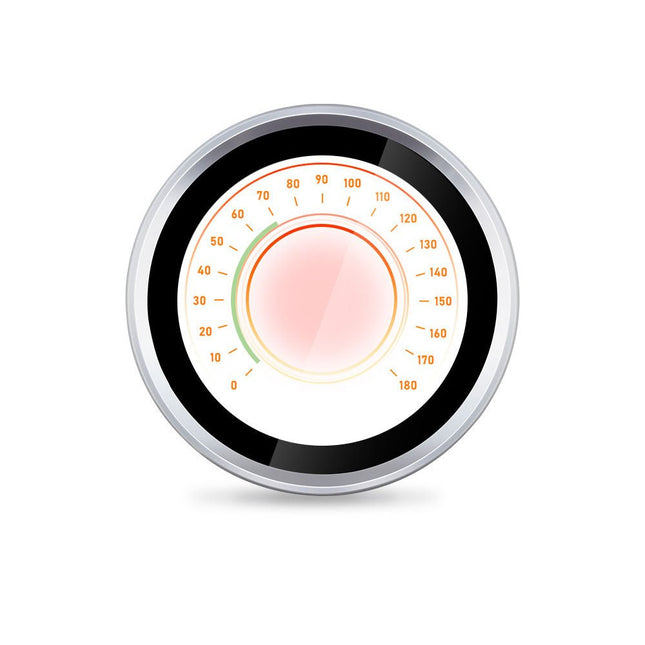
Makerfabs MaTouch ESP32-S3 Drehbares 2,1" Touch-Display (ST7701)
Dieses Display verfügt über eine IPS-Auflösung von 480 x 480 mit kapazitivem Touch und einer Bildrate von bis zu 75 FPS. Es ist sehr hell und hat 65.000 Farben. Der mechanische Drehgeber unterstützt die Rechts-/Linksdrehung und unterstützt zudem den gesamten Pressvorgang, was in der Regel zur Bestätigung des Vorgangs genutzt werden kann. Das Anzeigemodul basiert auf ESP32-S3 mit WLAN & Bluetooth 5.0 zur einfachen Verbindung mit dem Internet für IoT-Projekte. Die Stromversorgung und Programmierung erfolgen direkt über den USB-Anschluss. Es verfügt außerdem über zwei Erweiterungsports, I²C und UART. Technische Daten Controller ESP32-S3 WROOM-1-N16R8 (16 MB Flash, 8 MB PSRAM, PCB-Antenne) Drahtlos WLAN & Bluetooth 5.0 Auflösung 480x480 LCD 2,1" IPS LCD mit 65.000 Farben LCD-Treiber ST7701S Bildrate >70 FPS LCD-Schnittstelle RGB 565 Touchpanel Kapazitive 5-Punkt-Berührung Touchpanel-Treiber CST8266 USB USB-C nativ Schnittstellen 1x I²C, 1x UART (1,25 mm, 4-poliger Stecker) Arduino-Unterstützung Ja Downloads Wiki Usage with Squareline/LVGL GitHub Datasheet_ESP32-S3-WROOM-1
€ 64,95€ 54,95
Mitglieder identisch
-
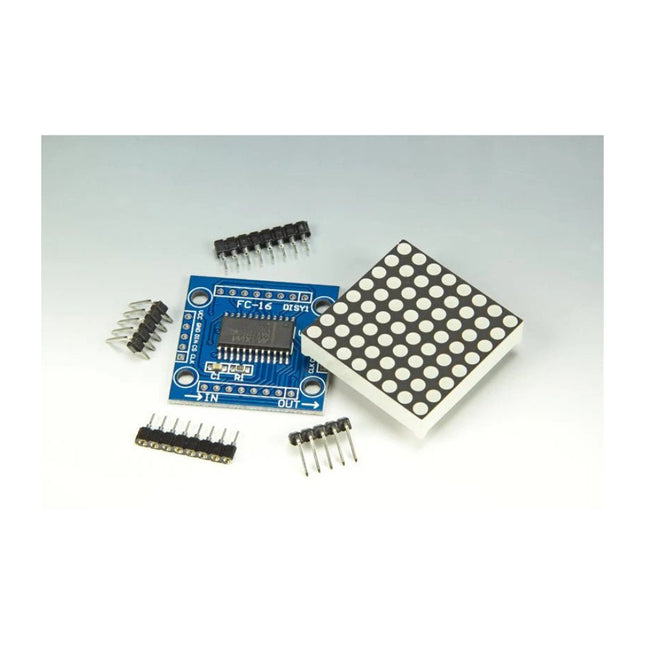
Elektor Labs MAX7219 Dot-Matrix-Modul (8er-Set)
Lauftextanzeige mit acht 8 x 8 LED-Punktmatrixanzeigen (insgesamt 512 LEDs). Basiert auf einem ESP-12F-WLAN-Modul (basierend auf ESP8266), das in der Arduino IDE programmiert wurde. Der ESP8266-Webserver ermöglicht die Steuerung des angezeigten Textes, der Bildlaufverzögerung und der Helligkeit mit einem Mobiltelefon oder einem anderen über WLAN verbundenen (tragbaren) Gerät. Merkmale 10 MHz Serielle Schnittstelle Individuelle LED-Segmentsteuerung Dekodierung/Nicht-Dekodierung der Ziffernauswahl 150 µA Abschaltung bei niedrigem Stromverbrauch (Daten bleiben erhalten) Digitale und analoge Helligkeitsregelung Anzeige beim Einschalten dunkel LED-Anzeige mit gemeinsamer Kathode für Antrieb Segmenttreiber mit begrenzter Anstiegsrate für geringere elektromagnetische Störungen (MAX7221) SPI, QSPI, MICROWIRE Serielle Schnittstelle (MAX7221) 24-polige DIP- und SO-Gehäuse
€ 19,95
Mitglieder € 17,96
-
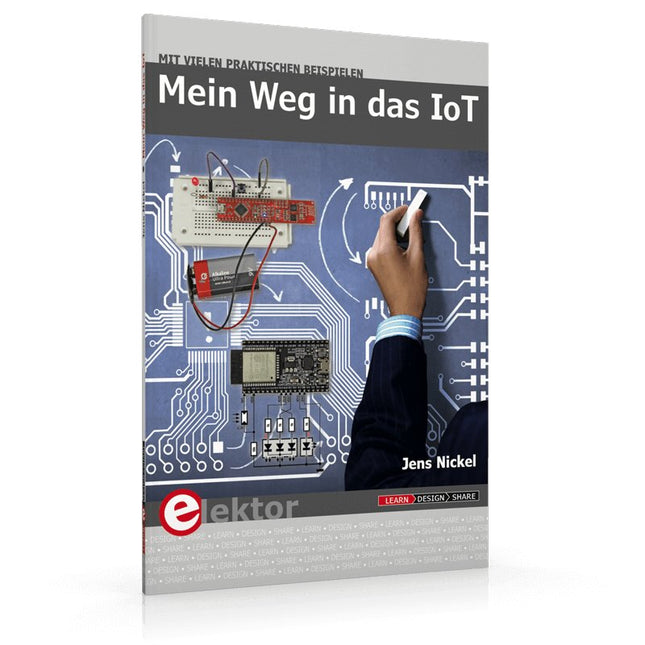
Elektor Publishing Mein Weg in das IoT
Das Internet of Things (IoT) wird unseren Alltag noch viel komfortabler machen als heute und dabei helfen, Geld und Ressourcen einzusparen. Der Einstieg ins Thema fällt allerdings nicht leicht. Denn auf dem Markt konkurrieren inzwischen unzählige Lösungen miteinander – meist sind es Bundles aus (Eval-)Boards, Software und einem Cloud-Zugang. Solche Kits versprechen schnelle Erfolge, doch ein fundierteres Wissen erhält nur derjenige, der ein eigenes Projekt von Grund auf realisiert. Jens Nickel – Chefredakteur der deutschen Elektor-Ausgabe – hat sich auf diesem Weg in das IoT gemacht. Im Rahmen einer Artikelserie entstanden Schritt für Schritt mehrere kleine Demo-Projekte, von der Lampensteuerung im Heimnetzwerk bis zum autarken Sensorboard, das Messwerte in die Cloud sendet. Nach dem Motto „Learning by Doing“ werden dabei Themen wie TCP/IP, MQTT, Steuerung per Smartphone, WLAN-Zugang, Embedded-Webserver, Anbindung eines Cloud-Service, Zuverlässigkeit bei Verbindungsabbrüchen, Objektorientierte Programmierung und vieles mehr behandelt. Die Demo-Programme (meist im einsteigerfreundlichen Arduino-C-Dialekt) stehen selbstverständlich im Quellcode zur Verfügung und sind damit leicht an eigene Bedürfnisse anpassbar. In diesem Buch sind die ersten 24 Folgen dieser Serie kompakt zusammengefasst. Mit der von Elektor gewohnten Mischung aus Theorie und Praxis geht es in das Internet of Things – seien Sie dabei!
€ 19,90
Mitglieder identisch
-
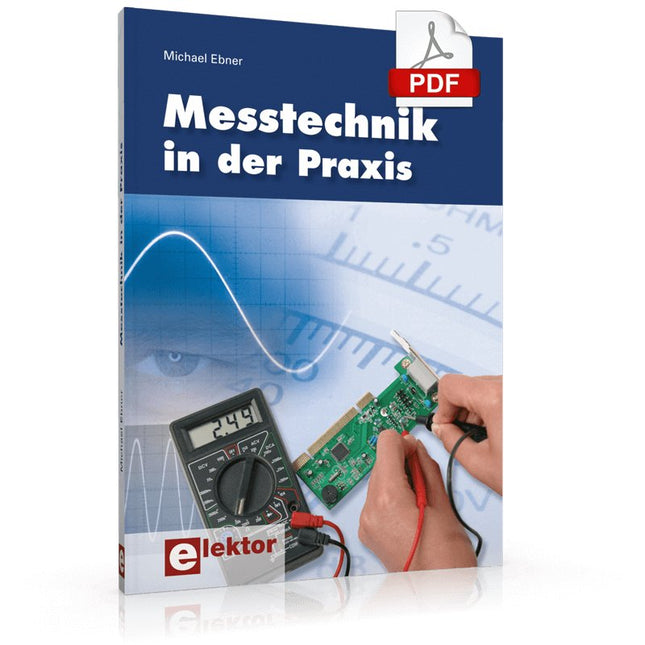
Elektor Digital Messtechnik in der Praxis (PDF)
Das Durchführen von Messungen gehört zu den grundlegenden Tätigkeiten eines jeden Elektronikers, wie das tägliche Brot zum Leben. Ob bei der Entwicklung von Schaltungen, der Überprüfung während der Produktion oder bei der Fehlersuche in defekten Geräten: Messgeräte sind das wichtigste Handwerkszeug und kommen stets zum Einsatz. „Wer misst, misst Mist“ lautet ein oft zitiertes Motto. Damit dem nicht so ist, muss der Elektroniker wissen, was er tut, muss die Genauigkeit seiner Messgeräte und vor allem die Schwachpunkte des Messverfahrens kennen. Hier setzt dieses Buch an: Ausgehend von theoretischen Betrachtungen und Begriffsdefinitionen geht die Reise von den einfachen Zeigerinstrumenten über Multimeter und Oszilloskop hin zu FFT-Analysen und spezialisierten Messgeräten wie Audio-Analyser, Schallpegelmesser, Geräte- und Installationstester.
€ 29,80
Mitglieder € 23,84
-
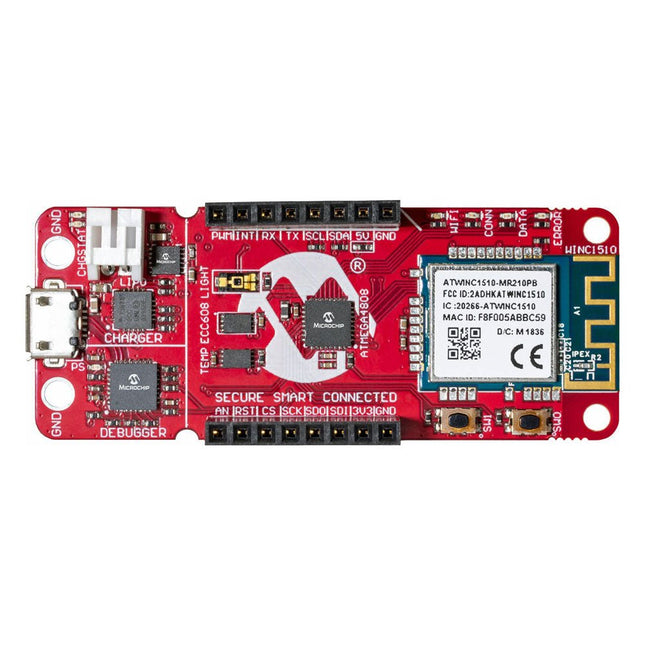
Microchip Microchip AVR-IoT WA-Entwicklungsboard
Das AVR-IoT WA-Entwicklungsboard kombiniert einen leistungsstarken ATmega4808 AVR MCU, einen ATECC608A CryptoAuthentication™ Secure Element IC und den vollständig zertifizierten ATWINC1510 Wi-Fi-Netzwerkcontroller – was die einfachste und effektivste Möglichkeit bietet, Ihre eingebettete Anwendung mit Amazon Web Services zu verbinden ( AWS). Das Board verfügt außerdem über einen integrierten Debugger und erfordert keine externe Hardware zum Programmieren und Debuggen der MCU. Im Auslieferungszustand ist auf der MCU ein Firmware-Image vorinstalliert, mit dem Sie mithilfe der integrierten Temperatur- und Lichtsensoren schnell eine Verbindung zur AWS-Plattform herstellen und Daten an diese senden können. Sobald Sie bereit sind, Ihr eigenes benutzerdefiniertes Design zu erstellen, können Sie mithilfe der kostenlosen Softwarebibliotheken in Atmel START oder MPLAB Code Configurator (MCC) ganz einfach Code generieren. Das AVR-IoT WA-Board wird von zwei preisgekrönten integrierten Entwicklungsumgebungen (IDEs) unterstützt – Atmel Studio und Microchip MPLAB X IDE – und gibt Ihnen die Freiheit, mit der Umgebung Ihrer Wahl Innovationen zu entwickeln. Merkmale ATmega4808 Mikrocontroller Vier Benutzer-LEDs Zwei mechanische Tasten mikroBUS-Header-Footprint TEMT6000 Lichtsensor MCP9808 Temperatursensor ATECC608A CryptoAuthentication™-Gerät WINC1510 WiFi-Modul Onboard-Debugger Auto-ID zur Platinenidentifizierung in Atmel Studio und Microchip MPLAB Eine grüne Betriebs- und Status-LED auf der Platine Programmieren und Debuggen Virtueller COM-Port (CDC) Zwei DGI GPIO-Leitungen USB- und batteriebetrieben Integriertes Li-Ion/LiPo-Akkuladegerät
€ 39,95€ 29,95
Mitglieder identisch
-

Elektor Digital Microprocessor Design Using Verilog HDL (E-book)
If you have the right tools, designing a microprocessor shouldn’t be complicated. The Verilog hardware description language (HDL) is one such tool. It can enable you to depict, simulate, and synthesize an electronic design, and thus increase your productivity by reducing the overall workload associated with a given project.Monte Dalrymple’s Microprocessor Design Using Verilog HDL is a practical guide to processor design in the real world. It presents the Verilog HDL in a straightforward fashion and serves as a detailed introduction to reducing the computer architecture and as an instruction set to practice. You’re led through the microprocessor design process from start to finish, and essential topics ranging from writing in Verilog to debugging and testing are laid bare.The book details the following, and more: Verilog HDL Review: data types, bit widths/labeling, operations, statements, and design hierarchy Verilog Coding Style: files vs. modules, indentation, and design organization Design Work: instruction set architecture, external bus interface, and machine cycle Microarchitecture: design spreadsheet and essential worksheets (e.g., Operation, Instruction Code, and Next State) Writing in Verilog: choosing encoding, assigning states in a state machine, and files (e.g., defines.v, hierarchy.v, machine.v) Debugging, Verification, and Testing: debugging requirements, verification requirements, testing requirements, and the test bench Post Simulation: enhancements and reduction to practice Monte Dalrymple received a BSEE (with highest honors) and an MSEE from the University of California at Berkeley, where he was elected to Phi Beta Kappa. Monte started his career at Zilog, where he designed a number of successful products, including the Serial Communication Controller (SCC) family and the Universal Serial Controller (USC) family. He was also the architect and lead designer of the Z380 microprocessor. Monte started his own company, Systemyde International Corp., in 1995, and has been doing contract design work ever since. He designed all five generations of Rabbit microprocessors, a Z180 clone that is flying on the Juno mission to Jupiter, and a Z8000 clone that flies in a commercial avionics air data computer. Monte holds 16 patents as well as both amateur and commercial radio licenses. Monte wrote 10 articles for Circuit Cellar magazine between 1996 and 2010. He recently completed a side project to replace the CPU in an HP-41C calculator with a modern FPGA-based version.
€ 29,95
Mitglieder € 23,96
-

Elektor Publishing MicroPython für Mikrocontroller
Die Programmiersprache „Python“ hat in den letzten Jahren einen enormen Aufschwung erlebt. Nicht zuletzt haben verschiedene Einplatinensysteme wie der Raspberry Pi zu deren Bekanntheitsgrad beigetragen. Aber auch in anderen Gebieten, wie der Künstlichen Intelligenz oder dem Machine Learning, hat Python weite Verbreitung gefunden. Es ist daher naheliegend, Python bzw. die Variante „MicroPython“ auch für den Einsatz in SoCs (Systems on Chip) zu verwenden. Leistungsfähige Controller wie der ESP32 der Firma Espressif Systems bieten eine hervorragende Performance sowie Wi-Fi- und Bluetooth-Funktionalität zu einem günstigen Preis. Mit diesen Eigenschaften wurde die Maker-Szene im Sturm erobert. Im Vergleich zu anderen Controllern weist der ESP32 einen deutlich größeren Flash und SRAM-Speicher, sowie eine wesentlich höhere CPU-Geschwindigkeit auf. Aufgrund dieser Leistungsmerkmale eignet sich der Chip nicht nur für klassische C-Anwendungen, sondern insbesondere auch für die Programmierung mit MicroPython. Das vorliegende Buch führt in die Anwendung der modernen Ein-Chip-Systeme ein. Neben den technischen Hintergründen steht vor allem MicroPython selbst im Vordergrund. Nach der Einführung in die Sprache werden die erlernten Programmierkenntnisse umgehend in die Praxis umgesetzt. Die einzelnen Projekte sind sowohl für den Einsatz im Labor als auch für Alltagsanwendungen geeignet. Neben dem eigentlichen Lerneffekt steht also auch die Freude am Aufbau kompletter und nützlicher Geräte im Vordergrund. Durch die Verwendung von Laborsteckboards können Schaltungen aller Art mit geringem Aufwand realisiert werden, sodass das Austesten der selbstgebauten Geräte zum lehrreichen Vergnügen wird. Durch die verschiedenen Anwendungen wie Wetterstationen, Digitalvoltmeter, Ultraschall-Entfernungsmesser, RFID-Kartenleser oder Funktionsgeneratoren sind die vorgestellten Projekte auch für Praktika oder Fach- und Studienarbeiten in den Naturwissenschaften bzw. im Natur- und Technikunterricht bestens geeignet.
€ 39,80
Mitglieder identisch
-

Elektor Digital MicroPython für Mikrocontroller (PDF)
Die Programmiersprache „Python“ hat in den letzten Jahren einen enormen Aufschwung erlebt. Nicht zuletzt haben verschiedene Einplatinensysteme wie der Raspberry Pi zu deren Bekanntheitsgrad beigetragen. Aber auch in anderen Gebieten, wie der Künstlichen Intelligenz oder dem Machine Learning, hat Python weite Verbreitung gefunden. Es ist daher naheliegend, Python bzw. die Variante „MicroPython“ auch für den Einsatz in SoCs (Systems on Chip) zu verwenden. Leistungsfähige Controller wie der ESP32 der Firma Espressif Systems bieten eine hervorragende Performance sowie Wi-Fi- und Bluetooth-Funktionalität zu einem günstigen Preis. Mit diesen Eigenschaften wurde die Maker-Szene im Sturm erobert. Im Vergleich zu anderen Controllern weist der ESP32 einen deutlich größeren Flash und SRAM-Speicher, sowie eine wesentlich höhere CPU-Geschwindigkeit auf. Aufgrund dieser Leistungsmerkmale eignet sich der Chip nicht nur für klassische C-Anwendungen, sondern insbesondere auch für die Programmierung mit MicroPython. Das vorliegende Buch führt in die Anwendung der modernen Ein-Chip-Systeme ein. Neben den technischen Hintergründen steht vor allem MicroPython selbst im Vordergrund. Nach der Einführung in die Sprache werden die erlernten Programmierkenntnisse umgehend in die Praxis umgesetzt. Die einzelnen Projekte sind sowohl für den Einsatz im Labor als auch für Alltagsanwendungen geeignet. Neben dem eigentlichen Lerneffekt steht also auch die Freude am Aufbau kompletter und nützlicher Geräte im Vordergrund. Durch die Verwendung von Laborsteckboards können Schaltungen aller Art mit geringem Aufwand realisiert werden, sodass das Austesten der selbstgebauten Geräte zum lehrreichen Vergnügen wird. Durch die verschiedenen Anwendungen wie Wetterstationen, Digitalvoltmeter, Ultraschall-Entfernungsmesser, RFID-Kartenleser oder Funktionsgeneratoren sind die vorgestellten Projekte auch für Praktika oder Fach- und Studienarbeiten in den Naturwissenschaften bzw. im Natur- und Technikunterricht bestens geeignet.
€ 32,80
Mitglieder € 26,24























